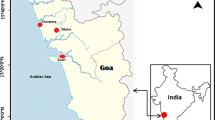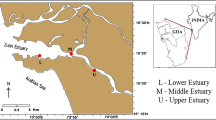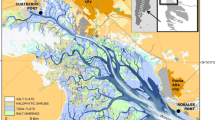Abstract
The concentrations of Cd, Cu and Zn in both the whole soft tissue and separate organs (gills, mantle, muscle and digestive gland) of wild bivalves (Mytilus galloprovincialis, Pinctada radiata, Venus verrucosa and Callista chione) from three different coastal microenvironments of Greece were monitored from 2003 to 2004. In parallel, by employing appropriate analytical protocols for metal partitioning, the labile fraction of the metals was determined in the dissolved phase, suspended particulate matter and sediments. Differences in the metal levels were detected both among the study areas as well as among the bivalves examined. Significant bioaccumulation was demonstrated regarding Zn in M. galloprovincialis specimens from the highly industrialized Gulf of Elefsis and Cd in P. radiata and V. verrucosa from the Maliakos Gulf, which is influenced by extended agricultural activity occurring at the neighbouring area and a river outflow. Data of the metal levels in the various environmental phases were correlated with their concentrations in bivalves’ tissues. The clear relationships obtained in many cases among the labile metal concentrations and the bioaccumulated concentrations in bivalves point out that the labile fraction of a metal is the most bioavailable. The lack of positive correlation for C. chione confirms the occurrence of effective mechanisms of internal regulation of metal concentrations.




Similar content being viewed by others
References
Bartolomé, L., Navarro, P., Raposo, J. C., Arana, G., Zuloaga, O., Etxebarria, N., et al. (2010). Occurrence and distribution of metals in mussels from the Cantabrian coast. Archives of Environmental Contamination and Toxicology, 59, 235–243.
Besada, V., Fumega, J., & Vaamonde, A. (2002). Temporal trends of Cd, Cu, Hg, Pb and Zn in mussel (Mytilus galloprovincialis) from the Spanish North-Atlantic coast 1991–1999. Science of the Total Environment, 288, 239–253.
Chen, W. Y., Liao, C. M., Jou, L. J., & Jau, S. F. (2010). Predicting bioavailability and bioaccumulation of arsenic by freshwater clam Corbicula fluminea using valve daily activity. Environmental Monitoring and Assessment, 169, 647–659.
Chong, K., & Wang, W. X. (2001). Comparative studies on the biokinetics of Cd, Cr and Zn in the green mussel Perna viridis and the Manila clam Ruditapes philippinarum. Environmental Pollution, 115, 107–121.
Coale, K. H., & Bruland, K. W. (1988). Copper complexation in the Northeast Pacific. Limnology and Oceanography, 33, 1084–1101.
Cobelo-Garcia, A., & Prego, R. (2004). Chemical speciation of dissolved copper, lead and zinc in a ria coastal system: the role of resuspended sediments. Analytica Chimica Acta, 524, 109–114.
Cotté-Krief, M. H., Thomas, A. J., & Martin, J. M. (2002). Trace metal (Cd, Cu, Ni and Pb) cycling in the upper water column near the shelf edge of the European continental margin (Celtic Sea). Marine Chemistry, 79, 1–26.
Danielsson, L. G., Magnusson, B., Westerland, S., & Zhang, K. (1982). Trace metal determination in estuarine waters by electrothermal AAS after extraction of dithiocarbamate complexes into Freon. Analytica Chimica Acta, 144, 183–188.
Davison, W., & Zhang, H. (1994). In-situ speciation measurements of trace components in natural waters using thin film gels. Nature, 367, 546–548.
De Kock, W. C., & Kramer, K. J. M. (1994). Active biomonitoring (ABM) by translocation of bivalve molluscs. In K. J. M. Kramer (Ed.), Biomonitoring of coastal waters and estuaries (pp. 51–84). Boca Raton: CRC.
Di Toro, D. M., Mahony, J. D., Hansen, D. J., Scott, K. J., Hicks, M. B., Mayr, S. M., et al. (1990). Toxicity of cadmium in sediments: the role of acid volatile sulphide. Environmental Toxicology and Chemistry, 9, 1489–1504.
Dimitriadis, V. K., Domouhtsidou, G. P., & Raftopoulou, E. (2003). Localization of Hg and Pb in the palps, the digestive gland and the gills in Mytilus galloprovincialis (L.) using autometallography and X-ray microanalysis. Environmental Pollution, 125, 345–353.
Donat, J. R., & Bruland, K. W. (1990). A comparison of 2 voltammetric techniques for determining zinc speciation in Northeast Pacific-Ocean waters. Marine Chemistry, 28, 301–323.
Ellwood, M. J., & van den Berg, C. M. G. (2000). Zinc speciation in the Northeastern Atlantic Ocean. Marine Chemistry, 68, 295–306.
Eriksen, R. S., Mackey, D. J., van Dam, R., & Nowak, B. (2001). Copper speciation and toxicity in Macquarie Harbour, Tasmania: an investigation using copper ion selective electrode. Marine Chemistry, 74, 99–113.
Fischer, H. (1984). Cadmium body burden/shell weight of mussels: a precise index for environmental monitoring. Community Meeting International Council Explore Sea CM-ICES/E, 41, 1–19.
Fischer, H. (1988). Mytilus edulis as a quantitative indicator of dissolved cadmium. Final study and synthesis. Marine Ecology Progress Series, 48, 163–174.
Fisher, N. S., Teyssie, J. L., Fowler, S. W., & Wang, W. X. (1996). Accumulation and retention of metals in mussels from food and water: a comparison under field and laboratory conditions. Environmental Science and Technology, 30, 3232–3242.
Franco, J., Borja, Á., Solaun, O., & Pérez, V. (2002). Heavy metals in molluscs from the Basque Coast (Northern Spain): results from an 11-year monitoring programme. Marine Pollution Bulletin, 44, 973–976.
Giarratano, E., & Amin, O. A. (2010). Heavy metals monitoring in the southernmost mussel farm of the world (Beagle Channel, Argentina). Ecotoxicology and Environmental Safety, 73, 1378–1384.
Gledhill, M., Nimmo, M., Hill, S. J., & Brown, M. T. (1999). The release of copper-complexing ligands by the brown alga Fucus vesiculosus (Phaeophyceae) in response to increasing total copper levels. Journal of Phycology, 35, 501–509.
Goldberg, E. D., Koide, M., Hodge, V., Flegal, A. R., & Martin, J. H. (1983). US Mussel Watch: 1977–1978 results on trace metals and radionuclides. Estuarine, Coastal and Shelf Science, 16, 69–93.
Griscom, S. B., & Fisher, N. S. (2002). Uptake of dissolved Ag, Cd and Co by the clam Macoma bathica: relative importance of overlying water, oxic pore water and burrow water. Environmental Science and Technology, 36, 2471–2478.
Kavun, V. Y., & Podgurskaya, O. V. (2009). Adaptation strategy of bivalve Modiolus modiolus from upwelling regions of the Kuril Islands shelf (Sea of Okhotsk) to heavy metal effects. Continental Shelf Research, 29, 1597–1604.
Ke, C., & Wang, W. X. (2001). Bioaccumulation of Cd, Se and Zn in an estuarine oyster (Crassostrea rivularis) and a coastal oyster (Saccostrea glomerata). Aquatic Toxicology, 56, 33–51.
Kimbrough, K.L., Johnson, W.E., Lauenstein, G.G., Christensen, J.D. & Apeti, D. A. (2008). An assessment of two decades of contaminant monitoring in the nation’s coastal zone. Silver Spring, MD, NOAA, Technical Memorandum NOS NCCOS 74.
Kozelka, P. B., & Bruland, K. W. (1998). Chemical speciation of dissolved Cu, Zn, Cd, Pb in Narragansett Bay, Rhode Island. Marine Chemistry, 60, 267–282.
Kucuksezgin, F., Kacar, A., Kucuksezgin, G., & Ulaturhan, E. (2010). Monitoring metal contamination levels and fecal pollution in clam (Tapes decassatus) collected from Izmir Bay (Turkey). Environmental Monitoring and Assessment, 162, 407–415.
Lewis, B. L., & Landing, W. M. (1992). The investigation of dissolved and suspended-particulate trace metal fractionation in the Black Sea. Marine Chemistry, 40, 105–141.
Lobel, P. B., & Wright, D. A. (1982). Total body zinc concentration and allometric growth ratios in Mytilus edulis collected from different shore levels. Marine Biology, 66, 231–236.
Luoma, S. N. (1983). Bioavailability of trace metals to aquatic organisms—a review. Science of the Total Environment, 28, 1–22.
Luoma, S. N. (1989). Can we determine the biological availability of sediment-bound trace elements? Hydrobiologia, 176/177, 379–396.
Luoma, S. N. (1995). Prediction of metal toxicity in nature from bioassays: limitations and research needs. In A. Tessier & D. R. Turner (Eds.), Metal speciation and bioavailability in aquatic systems (Vol. 3, pp. 609–646). Chichester: Wiley.
Luten, J. B., Bouquet, W., Burggraaf, M. M., Rauchbaar, A. B., & Rus, J. (1986). Trace metals in mussels (Mytilus edulis) from the Waddenzee, coastal North Sea and the estuaries of Ems, Westerschelden and Eastern Scheldt. Bulletin of Environmental Contamination and Toxicology, 39, 770–777.
Moffett, J. W., & Brand, L. E. (1996). The production of strong, extracellular Cu chelators by marine cyanobacteria in response to Cu stress. Limnology and Oceanography, 41, 288–293.
O’Connor, T. P. (1994). The National Oceanic and Atmospheric Administration (NOAA) National Status and Trends Mussel Watch Program: national monitoring of chemical contamination in the coastal United States. In C. R. Cothern & N. P. Ross (Eds.), Environmental statistics, assessment and forecasting (pp. 331–349). Boca Raton: Lewis.
Phillips, D. J. H. (1976). The common mussel Mytilus edulis as an indicator of pollution by zinc, cadmium, lead and copper. II. Relationship of metals in the mussel to those discharged by industry. Marine Biology, 38, 71–80.
Rainbow, P. S. (2002). Trace metal concentrations in aquatic invertebrates: why and so what? Environmental Pollution, 120, 497–507.
Regoli, F., & Orlando, E. (1993). Mytilus galloprovincialis as a bioindicator of lead pollution: biological variables and cellular responses. Science of the Total Environment, 134, 1283–1292.
Riedel, G. F., Abbe, G. R., & Sanders, J. G. (1998). Temporal and spatial variations of trace metal concentrations in oysters from the Patuxent River, Maryland. Estuaries and Coasts, 21, 423–434.
Riget, F., Johansen, P., & Asmund, G. (1996). Influence of length on element concentrations in blue mussels (Mytilus edulis). Marine Pollution Bulletin, 32, 745–751.
Roméo, M., & Gnassia-Barelli, M. (1988). Donax trunculus and Venus verrucosa as bioindicators of trace metal concentrations in Mauritanian coastal waters. Marine Biology, 99, 223–227.
Sakellari, A., Plavšić, M., Karavoltsos, S., Dassenakis, M., & Scoullos, M. (2011). Assessment of copper, cadmium and zinc remobilization in Mediterranean coastal sediments. Estuarine, Coastal and Shelf Science, 91, 1–12.
Scoullos, M. (1979). Chemical studies of the Gulf of Elefsis. PhD thesis, University of Liverpool.
Scoullos, M., Plavšić, M., Karavoltsos, S., & Sakellari, A. (2006). Partitioning and distribution of dissolved copper, cadmium and organic matter in Mediterranean marine coastal areas: the case of a mucilage event. Estuarine, Coastal and Shelf Science, 67, 484–490.
Shulkin, V. M., Presley, B. J., & Kavun, V. I. (2003). Metal concentrations in mussel Crenomytilus grayanus and oyster Crassostrea gigas in relation to contamination of ambient sediments. Environment International, 29, 493–502.
Soto, M., Kortabitarte, M., & Marigómez, I. (1995). Bioavailable heavy metals in estuarine waters as assessed by metal/shell-weight indices in sentinel mussels Mytilus galloprovincialis. Marine Ecology Progress Series, 125, 127–136.
Struck, B. D., Pelzer, R., Ostapczuk, P., Emons, H., & Mohl, C. (1997). Statistical evaluation of ecosystem properties influencing the uptake of As, Cd, Co, Cu, Hg, Mn, Ni, Pb and Zn in seaweed (Fucus vesiculosus) and common mussel (Mytilus edulis). Science of the Total Environment, 207, 29–42.
Tarique, Q., Burger, J., & Reinfelder, J. R. (2012). Metal concentrations in organs of the clam Amiantis umbonella and their use in monitoring metal contamination of coastal sediments. Water, Air and Soil Pollution, 223, 2125–2136.
US Environmental Protection Agency (1997). Guidelines establishing test procedures for the analysis of pollutants (App. B to Part 136). Definition and procedure for the determination of the method detection limit): U.S. Code of Federal Regulations, Title 40, revised as of July 1, 1997, pp. 265–267.
Wang, W. X., & Fisher, N. S. (1999). Delineating metal accumulation pathways for marine invertebrates. Science of the Total Environment, 237–238, 459–472.
Wen, L. S., Santschi, P. H., Gill, G. A., Paternostro, C. L., & Lehman, R. D. (1997). Colloidal and particulate silver in river and estuarine waters of Texas. Environmental Science and Technology, 31, 723–731.
Yang, R. J., & van den Berg, C. M. G. (2009). Metal complexation by humic substances in seawater. Environmental Science and Technology, 43(19), 7192–7197.
Acknowledgments
We thank the anonymous referees for their constructive comments and suggestions.
Author information
Authors and Affiliations
Corresponding author
Rights and permissions
About this article
Cite this article
Sakellari, A., Karavoltsos, S., Theodorou, D. et al. Bioaccumulation of metals (Cd, Cu, Zn) by the marine bivalves M. galloprovincialis, P. radiata, V. verrucosa and C. chione in Mediterranean coastal microenvironments: association with metal bioavailability. Environ Monit Assess 185, 3383–3395 (2013). https://doi.org/10.1007/s10661-012-2799-2
Received:
Accepted:
Published:
Issue Date:
DOI: https://doi.org/10.1007/s10661-012-2799-2




